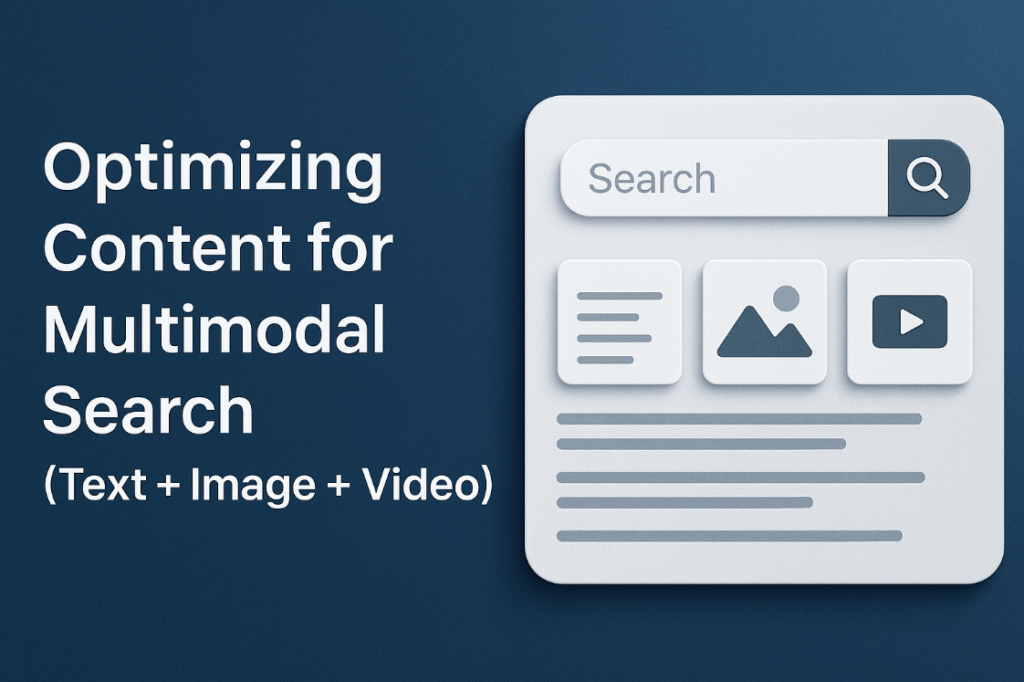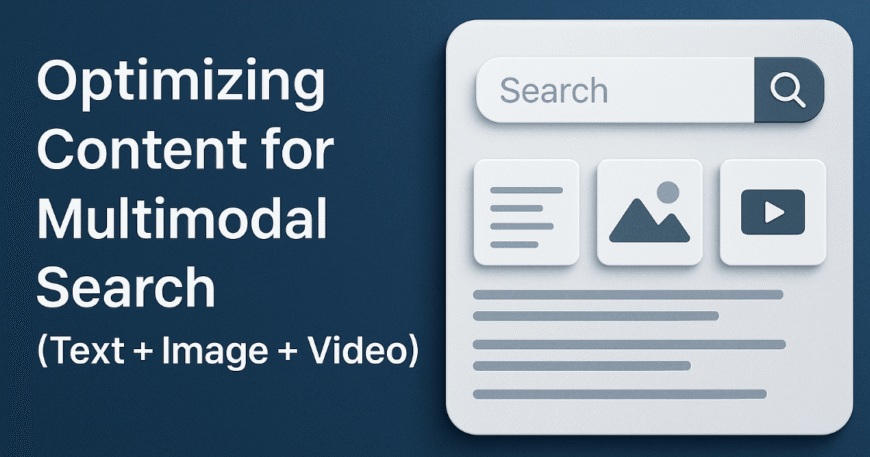
Table of Contents
- Introduction to Multimodal Search
- The Core Elements of Multimodal Search
- SEO Strategies for Multimodal Optimization
- Tools and Platforms for Multimodal SEO
- Best Practices for Cross-Modal Consistency
- Future of Multimodal Search
- Conclusion
- FAQs
Introduction to Multimodal Search
What Is Multimodal Search?
Multimodal search allows users to search using a combination of inputs such as text, image, video, and even voice. Instead of relying solely on keywords, users can now upload a photo or speak a query, making search more intuitive and accessible.
Why Multimodal Search Matters in 2025
We’ve evolved past plain text queries. Today’s users expect smarter interactions and faster results. Whether it’s using a photo to search for fashion items or combining a video frame with a question, multimodal search delivers convenience and accuracy.
The Rise of Visual and Voice Inputs
Voice assistants, image-based apps, and smart search engines are now a regular part of our daily lives. Tools like Google Lens, Siri, and Alexa prove how users are embracing multimodal inputs for faster and more relevant answers.
The Core Elements of Multimodal Search
How Text, Images, and Videos Work Together
Multimodal search blends different forms of data to enhance accuracy. For instance, a blog post might contain an image, video explanation, and descriptive text—all contributing to how it ranks in search engines.
Examples of Multimodal Search in Action
Google Lens
Google Lens lets users search by pointing their phone’s camera at an object. It then identifies that object and provides context, links, or shopping options.
YouTube + Google Integration
Google now indexes YouTube videos not just by titles, but also by spoken content and timestamps, surfacing them in text-based queries.
Pinterest Visual Search
Pinterest allows users to select parts of an image to trigger a new search, enhancing product discovery through visual segmentation.
SEO Strategies for Multimodal Optimization
Optimizing Text for Multimodal Search
Schema Markup
Adding structured data helps search engines better understand the context of your content. Implement schemas for articles, products, videos, and images.
Natural Language Usage
Write conversationally. Answer questions in a human tone. This helps with both voice and AI-powered searches that understand natural queries.
Optimizing Images for Search Engines
Alt Text and Descriptions
Always include meaningful alt text. It serves as a descriptor for search bots and improves accessibility.
File Names and Formats
Rename your files with relevant keywords like “organic-green-tea.jpg” instead of “IMG_0193.jpg”. Use WebP or optimized JPEG formats for faster load times.
Compressing Without Quality Loss
Use compression tools like TinyPNG or ImageOptim to reduce file size. Large image files hurt page speed, which in turn impacts SEO.
Optimizing Video Content for Discovery
Captions, Transcripts, and Metadata
Upload captions and transcripts for every video. This improves accessibility, keyword matching, and overall indexability.
Thumbnails and Descriptions
Create eye-catching thumbnails and include keyword-rich descriptions to increase click-through rates and ranking potential.
Tools and Platforms for Multimodal SEO
AI Tools for Content Creation and Tagging
Leverage platforms like Jasper, Canva AI, and Lumen5 to create content and auto-generate tags, captions, and summaries for images and videos.
Analytics Platforms for Tracking Performance
Use tools like Google Search Console, SEMrush, Ahrefs, and YouTube Analytics to measure engagement, rankings, and technical performance across formats.
CMS Plugins for Visual and Video SEO
Use plugins like Yoast SEO, RankMath, and All in One Video Pack to automate structured data, sitemaps, and media optimizations.
Best Practices for Cross-Modal Consistency
Branding and Messaging Across Media Types
Maintain consistent color palettes, tone, logos, and key messages across all content formats. Uniform branding builds trust and improves brand recall.
Ensuring Semantic Relevance in All Modalities
If your blog is about electric cars, your images, videos, and metadata should all reflect that same topic. Consistency across modalities helps improve search relevance.
Future of Multimodal Search
How AI and AR Will Reshape Search
AR glasses, smart mirrors, and next-gen mobile devices will redefine how we input and retrieve data. AI will make these interactions seamless and hyper-personalized.
Predictions and Trends to Watch
- Voice-image combined queries will grow
- AR and spatial search will become mainstream
- Google will index 3D content for immersive experiences
- TikTok and Instagram will become powerful visual-first search engines
Conclusion
Multimodal search is no longer a futuristic concept—it’s today’s reality. Businesses and creators who adapt their content strategies for text, image, and video optimization will gain a significant competitive edge. The key is to think beyond keywords and consider every piece of content—written, visual, and spoken—as part of a unified search experience. The more harmonized and optimized your content is across all formats, the better you’ll perform in modern SERPs.
FAQs
1. What is multimodal search in SEO?
Multimodal search in SEO refers to optimizing content for discovery across multiple input types—text, image, video, and voice.
2. How do I make my images SEO-friendly?
Use descriptive file names, include alt text, choose proper formats (like WebP), and compress for faster loading without losing quality.
3. Why is video important in modern SEO?
Videos engage users longer, provide more context, and are prioritized in search results, especially with metadata and captions.
4. What are examples of multimodal search platforms?
Google Lens, Pinterest, YouTube-Google integration, and Amazon visual search are top examples of multimodal search engines.
5. What tools help with multimodal SEO?
Tools like Canva AI, Jasper, Yoast SEO, Google Search Console, and YouTube Studio assist with content creation and optimization across formats.



